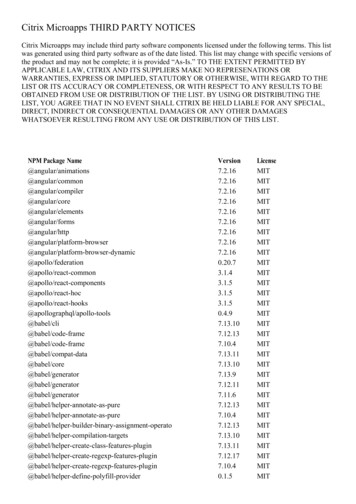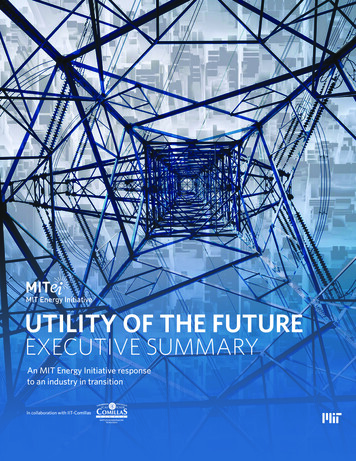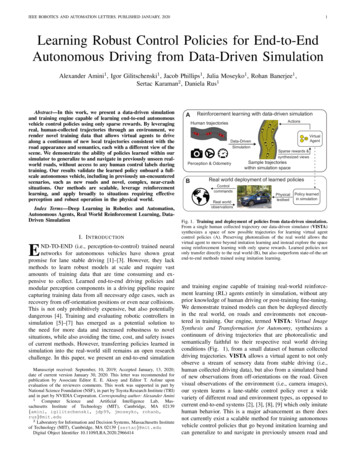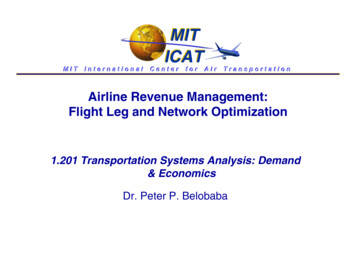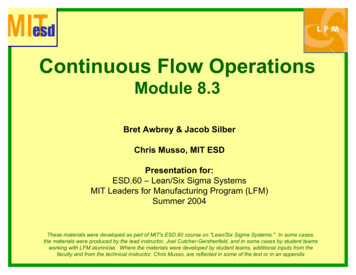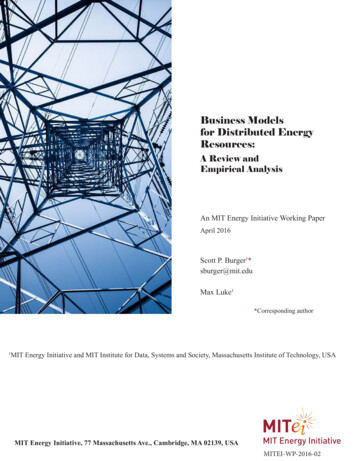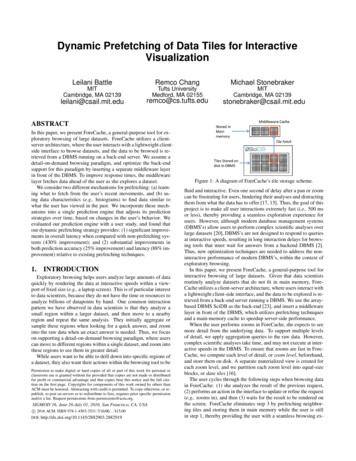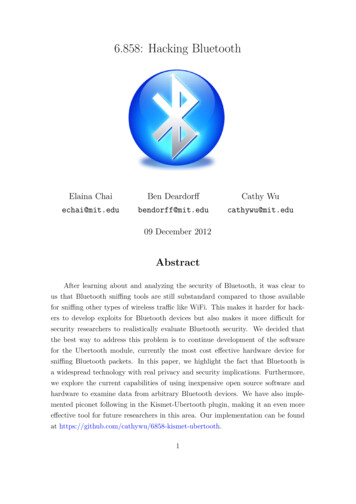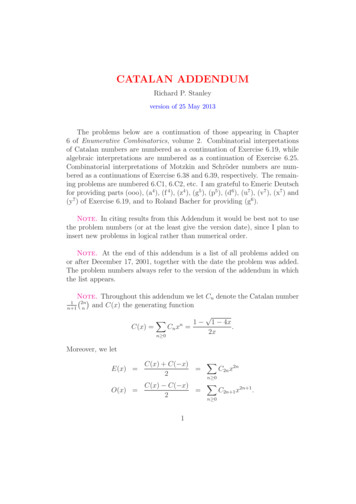
Transcription
CATALAN ADDENDUMRichard P. Stanleyversion of 25 May 2013The problems below are a continuation of those appearing in Chapter6 of Enumerative Combinatorics, volume 2. Combinatorial interpretationsof Catalan numbers are numbered as a continuation of Exercise 6.19, whilealgebraic interpretations are numbered as a continuation of Exercise 6.25.Combinatorial interpretations of Motzkin and Schröder numbers are numbered as a continuations of Exercise 6.38 and 6.39, respectively. The remaining problems are numbered 6.C1, 6.C2, etc. I am grateful to Emeric Deutschfor providing parts (ooo), (a4 ), (f 4 ), (z4 ), (g5 ), (p5 ), (d6 ), (u7 ), (v7 ), (x7 ) and(y7 ) of Exercise 6.19, and to Roland Bacher for providing (g6 ).Note. In citing results from this Addendum it would be best not to usethe problem numbers (or at the least give the version date), since I plan toinsert new problems in logical rather than numerical order.Note. At the end of this addendum is a list of all problems added onor after December 17, 2001, together with the date the problem was added.The problem numbers always refer to the version of the addendum in whichthe list appears.Note.Throughout this addendum we let Cn denote the Catalan number and C(x) the generating function2n1n 1 nC(x) XnCn x n 01 1 4x.2xMoreover, we letXC(x) C( x) C2n x2n2n 0XC(x) C( x)O(x) C2n 1 x2n 1 .2n 0E(x) 1
6.19(ooo) Plane trees with n 1 internal nodes, each having degree 1 or 2,such that nodes of degree 1 occur only on the rightmost path(ppp) Plane trees with n vertices, such that going from left to right allsubtrees of the root first have an even number of vertices andthen an odd number of vertices, with those subtrees with an oddnumber of vertices colored either red or blueRRRBBRBB(qqq) Plane trees with n vertices whose leaves at height one are coloredred or blueRRRBBRBB(rrr) Plane trees with n internal vertices such that each vertex has atmost two children and each left child of a vertex with two childrenis an internal vertex(sss) Plane trees for which every vertex has 0,1, or 3 children, with atotal of n 1 vertices with 0 or 1 child2
(ttt) Bicolored (i.e., each vertex is colored red or blue with no monochromatic edge) unrooted plane trees (i.e., unrooted trees with thesubtrees at each vertex cyclically ordered) with n 1 vertices,rooted at an edge (marked below)B*R*BRBRB**RBRBRR*RBBBBRR(uuu) Plane trees with n 1 vertices, each nonroot vertex labelled by apositive integer, such that (i) leaves have label 1, (ii) any nonroot,nonleaf vertex has label no greater than the sum of its children’slabels, and (iii) the only edges with no right neighbor are thoseon the rightmost path from the root112111111111111(vvv) Increasing plane trees on the vertex set [n 1] with increasingleaves in preorder (or from left-to-right), such that the path fromthe root 1 to n 1 contains every nonleaf vertex11123234211223443344(www) Rooted trees with n vertices such that each nonleaf vertex haseither a left child, a middle child, a right child, or a left and right3
child, and such that every left child has a left child, a right child,or both(xxx) Induced subtrees with n edges, rooted at an endpoint, of thehexagonal lattice, up to translation and rotation(yyy) Noncrossing increasing trees on the vertex set [n 1], i.e., treeswhose vertices are arranged in increasing order around a circlesuch that no edges cross in their interior, and such that all pathsfrom vertex 1 are increasing11421423412314234233(zzz) Nonnesting increasing trees on the vertex set [n 1], i.e., trees withroot 1 such that there do not not exist vertices h i j k suchthat both hk and ij are edges, and such that every path from theroot is increasing12314213434112223434(a4 ) Left factors L of Dyck paths such that L has n 1 up steps4
(b4 ) Dyck paths of length 2n 2 whose first downstep is followed byanother downstep(c4 ) Dyck paths of length 2n 2 with no peak (an upstep followedimmediately by a downstep) on the x-axis and having leftmostpeak at height 2 or 3(d4 ) Dyck paths of length 2n 2 for which the terminal descent is ofeven length and all other descents (if any) to the x-axis are ofodd length, where a descent is a maximal sequence of consecutivedown steps (compare (j))(e4 ) Dyck paths of length 4n such that every descent has length 2(f 4 ) Dyck paths with n 1 peaks and without three consecutive upsteps or three consecutive down steps5
(g4 ) Dyck paths with n peaks such that there are no factors (consecutive steps) UUU and UUDD(h4 ) Dyck paths of length 2n 2 whose second ascent (maximal sequence of consecutive up steps) has length 0 or 2(i4 ) Dyck paths D from (0, 0) to (2n 2, 0) such that there is nohorizontal line segment L with endpoints (i, j) and (2n 2 i, j),with i 0, such that the endpoints lie on P and no point of L liesabove D(j4 ) Points of the form (m, 0) on all Dyck paths from (0, 0) to (2n 2, 0)6
(k4 ) Peaks of height one (or hills) in all Dyck paths from (0, 0) to(2n, 0)(l4 ) Decompositions AUBDC of Dyck paths of length 2n (regarded asa sequence of U’s and D’s), such that B is Dyck path and suchthat A and C have the same lengthU UUDDDUU UDDDU UDUDDUUU DDDUDU DUD(m4 ) Vertices of height n 1 of the tree T defined by the property thatthe root has degree 2, and if the vertex x has degree k, then thechildren of x have degrees 2, 3, . . . , k 1(n4 ) Motzkin paths (as defined in Exercise 6.38(d), though with thetypographical error (n, n) instead of (n, 0)) from (0, 0) to (n 1, 0),with the steps (1, 0) colored either red or blueR RR BB RB B(o4 ) Motzkin paths from (0, 0) to (n, 0) with the steps (1, 0) coloredeither red or blue, and with no red (1, 0) steps on the x-axisBB B BBB7R
(p4 ) Peakless Motzkin paths having a total of n up and level steps(q4 ) Motzkin paths a1 , . . . , a2n 2 from (0, 0) to (2n 2, 0) such thateach odd step a2i 1 is either (1, 0) (straight) or (1, 1) (up), andeach even step a2i is either (1, 0) (straight) or (1, 1) (down)(r4 ) Motzkin paths with positive integer weights on the vertices of thepath such that the sum of the weights is n11 1 11 22 11 13(s4 ) Schröder paths as in Exercise 6.39(t) from (0, 0) to (2n, 0) withno peaks, i.e., no up step followed immediately by a down step(t4 ) Schröder paths as in Exercise 6.39(t) from (0, 0) to (2(n 1), 0)with peaks allowed only at the x-axis(u4 ) Schröder paths as in Exercise 6.39(t) from (0, 0) to (2n, 0) withneither peak nor level step at odd height8
(v4 ) Schröder paths as in Exercise 6.39(t) from (0, 0) to (2n 2, 0) withno valleys, i.e., no down step followed immediately by an up step(w4 ) Schröder paths as in Exercise 6.39(t) from (0, 0) to (2n 2, 0) withno double rises, i.e., no two consecutive up steps (for n 3 theset of paths is coincidentally the same as for (t4 ))(x4 ) Schröder paths as in Exercise 6.39(t) from (0, 0) to (2n, 0) withno level steps on the x-axis and no double rises(y4 ) Paths on N of length n 1 from 0 to 0 with steps 1, 1, 0, 0* ,i.e., there are two ways to take a step by standing still (the stepsin the path are given below)0, 00 , 00, 0 0 , 0 1, 1(z4 ) Lattice paths from (0, 0) to (n 1, n 1) with steps (0, 1), (1, 0),and (1, 1), never going below the line y x, such that the steps(1, 1) only appear on the line y x9
(a5 ) Lattice paths from (0, 0) with n 1 up steps (1, 1) and n 1 downsteps (1, 1), with no peaks at height h 0(b5 ) Lattice paths from (0, 0) with n up steps (1, 1) and n down steps(1, 1), with no peaks at height h 1(c5 ) Lattice paths from (0, 0) with n 1 steps (1, 1) and n 1 steps(1, 1), such that the interior vertices with even x-coordinate liestrictly above the line joining the intial and terminal points(d5 ) Lattice paths of length n 1 from (0, 0) to the x-axis with steps( 1, 0) and (0, 1), never going below the x-axis( 1, 0) ( 1, 0)( 1, 0) (1, 0)(1, 0) ( 1, 0)(0, 1) (0, 1)(1, 0) (1, 0)(e5 ) Nonnesting matchings on [2n], i.e., ways of connecting 2n points inthe plane lying on a horizontal line by n arcs, each arc connecting10
two of the points and lying above the points, such that no arc iscontained entirely below another(f5 ) Ways of connecting 2n points in the plane lying on a horizontalline by n vertex-disjoint arcs, each arc connecting two of the pointsand lying above the points, such that the following condition holds:for every edge e let n(e) be the number of edges e′ that nest e (i.e.,e lies below e′ ), and let c(e) be the number of edges e′ that beginto the left of e and that cross e. Then n(e) c(e) 0 or 1.(g5 ) Ways of connecting any number of points in the plane lying ona horizontal line by nonintersecting arcs lying above the points,such that the total number of arcs and isolated points is n 1 andno isolated point lies below an arc(h5 ) Ways of connecting n points in the plane lying on a horizontal lineby noncrossing arcs above the line such that if two arcs share anendpoint p, then p is a left endpoint of both the arcs(i5 ) Ways of connecting n 1 points in the plane lying on a horizontalline by noncrossing arcs above the line such that no arc connectsadjacent points and the right endpoints of the arcs are all distinct11
(j5 ) Ways of connecting n 1 points in the plane lying on a horizontal line by n noncrossing arcs above the line such that the leftendpoints of the arcs are distinct(k5 ) Ways of connecting 2n 2 points labelled 1, 2, . . . , 2n 2 lying ona horizontal line by nonintersecting arcs above the line such thatthe left endpoint of each arc is odd and the right endpoint is even.(l5 ) Noncrossing matchings of some vertex set [k] into n componentssuch that no two consecutive integers form an edge(m5 ) Lattice paths in the first quadrant with n steps from (0, 0) to (0, 0),where each step is of the form ( 1, 1), or goes from (2k, 0) to(2k, 0) or (2(k 1), 0), or goes from (0, 2k) to (0, 2k) or (0, 2(k 1))(0, 0) (0, 0) (0, 0) (0, 0)(0, 0) (0, 0) (1, 1) (0, 0)(0, 0) (1, 1) (0, 0) (0, 0)(0, 0) (2, 0) (1, 1) (0, 0)(0, 0) (0, 2) (1, 1) (0, 0)(n5 ) Lattice paths from (0, 0) to (n, n) such that (α) from a point(x, y) with x 2y the allowed steps are (1, 0) and (0, 1), (β) froma point (x, y) with x 2y the allowed steps are (0, 1) and (1, 1),(γ) from a point (2y, y) the allowed steps are (0, 1), (0, 1), and(1, 1), and (δ) it is forbidden to enter a point (2y 1, y)12
(o5 ) Symmetric parallelogram polyominos (as defined in the solutionto Exercise 6.19(l)) of perimeter 4(2n 1) such that the horizontalboundary steps on each level (equivalently, vertical boundary stepswith fixed x-coordinate) form an unbroken line(p5 ) All horizontal chords in the nonintersecting chord diagrams of(n) (with the vertices drawn so that one of the diagrams has nhorizontal chords)(q5 ) Kepler towers with n bricks, i.e., sets of concentric circles, with“bricks” (arcs) placed on each circle, as follows: the circles come insets called walls from the center outwards. The circles (or rings)of the ith wall are divided into 2i equal arcs, numbered 1, 2, . . . , 2iclockwise from due north. Each brick covers an arc and extendsslightly beyond the endpoints of the arc. No two consecutive arcscan be covered by bricks. The first (innermost) arc within eachwall has bricks at positions 1, 3, 5, . . . , 2i 1. Within each wall,each brick B not on the innermost ring must be supported byanother brick B ′ on the next ring toward the center, i.e., some rayfrom the center must intersect both B and B ′ . Finally, if i 1 andthe ith wall is nonempty, then wall i 1 must also by nonempty.Figure 1 shows a Kepler tower with three walls, six rings, and 13bricks.13
Figure 1: A Kepler tower with 3 walls, 6 rings, and 13 bricks(r5 ) Compositions of n whose parts equal to k are colored with one ofCk 1 colors (colors are indicated by subscripts below)1 1 1 1 2 2 1 3a3b(s5 ) Sequences (aP1 , . . . , an ) of nonnegative integers satisfying a1 · · · ai i andaj n111 120 210 201 300(t5 ) Sequences 1 a1 a2 · · · an n of integers with exactlyone fixed point, i.e., exactly one value of i for which ai i111 112 222 233 333(u5 ) Sequences a1 , a2 , . . . , an of positive integers such that the first appearance of i 1 occurs before the first appearance of i 1, andthere are no subsequences of the form abab11111214121122123
(v5 ) Sequences 1 a1 a2 · · · an 2n such that ai 2i246 256 346 356 456(w5 ) Sequences 1 a1 a2 · · · an 2n such that ai 2i 1(x5 ) Number of pairs of integer sequences 1 a1 a2 · · · ak n and 1 b1 b2 · · · bk n for which there exists apermutation w Sn whose left-to-right maxima (or records) aregiven by w(ai ) bi(123, 123) (12, 13) (13, 23) (12, 23) (1, 3)(y5 ) Sequences a0 , . . . , an defined recursively as follows: 1 is an allowedsequence (the case n 0). A sequence a0 , ., an is obtained fromone for n 1 by either appending 1 at the end, or by insertingbetween two consecutive terms their sum1111 1211 1121 1231 1321(z5 ) Sequences a1 , . . . , a2n of nonnegative integers with a1 1, a2n 0and ai ai 1 1:123210 121210 121010 101210 101010(a6 ) Sequences w a1 · · · an 1 of nonnegative integers such that ak 1 ak 1 for all 1 k n, and such that if w contains an i 1, thenthe first i lies between two i 1’s (not necessarily consecutively)00000010010001010110(b6 ) Sequences a1 , . . . , an of nonnegative integers with a1 0 and for2 i n:max{a1 , . . . , ai 1 } 1 ai asc(a1 , . . . , ai 1 ) 1,where asc(a1 , . . . , ai 1 ) denotes the number of ascents (indices 1 j n 1 for which aj aj 1 ) of the sequence (a1 , . . . , ai 1 )000 001 010 011 01215
P ai (c6 ) Sequences a1 , . . . , an 1 of nonnegative integers such that n 1i 1 2Pj 1aj ai1 and for all all 2 j n 1 the number 2is an ini 1 2teger12331332222223313321(d6 ) Sequences of n 1 1’s and any number of 1’s such that everypartial sum is nonnegative1, 11, 1, 11, 1, 11, 1, 1, 11, 1, 1, 1(e6 ) Subsequences of the sequence(a1 , a2 , . . . , a2n 2 ) (1, 1, 1, 1, . . . , 1, 1)that are ballot sequences (as defined in Corollary 6.2.3(ii)) (a1 , a2 )(a1 , a4 )(a3 , a4 )(a1 , a2 , a3 , a4 )(f6 ) Sequences a1 a2 · · · a2n 2 of n 1 1’s and n 1 1’s such that ifai 1 then either ai 1 ai 2 · · · a2n 2 1 or ai 1 ai 2 · · · ai j 0 for some j 11, 1, 1, 1 1, 1, 1, 1 1, 1, 1, 1 1, 1, 1, 1 1, 1, 1, 1(g6 ) Sequences a1 a2 · · · an of integers such that a1 1, an 1, ai 6 0,and ai 1 {ai , ai 1, ai 1, ai } for 2 i n1, 1, 11, 1, 11, 1, 11, 1, 11, 2, 1(h6 ) Sequences a1 a2 · · · an of nonnegative integers such that aj #{i :i j, ai aj } for 1 j n000002010011012(i6 ) Sequences a1 a2 · · · an 1 of nonnegative integers such that eachnonzero term initiates a factor (subsequence of consecutive elements) whose length is equal to its sum00 01 10 11 2016
(j6 ) Sequences a1 a2 · · · a2n 1 of positive integers such that a2n 1 1,some ai n 1, the first appearance of i 1 follows the firstappearance of i, no two consecutive terms are equal, no pair ij ofintegers occur more than once as a factor (i.e., as two consecutiveterms), and if ij is a factor then so is ji1213141 1213431 1232141 1232421 1234321(k6 ) Sequences (a1 , . . . , an ) Nn for which there exists a distributivelattice of rank n with ai join-irreducibles of rank i, 1 i n300 210 120 201 111(l6 ) Pairs of sequences 1 i1 i2 · · · ik n 1 and 2 j1 · · · jk n such that ir jr for all r.( , ) (1, 2) (1, 3) (2, 3) (12, 23)(m6 ) Distinct sets S obtained by starting with a permutation w S2nand continually crossing out the smallest element and then removing the leftmost element and placing it in S, until no elementsremain. For instance, if w 324165, then cross out 1 and place 3in S, then cross out 2 and place 4 in S, and then cross out 5 andplace 6 in S, obtaining S {3, 4, 6}.{2, 4, 6},{2, 5, 6},{3, 4, 6},{3, 5, 6},{4, 5, 6}(n6 ) Ways two persons can each start with 0 and alternatingly addpositive integers to their numbers so that they first have equalnumbers when that number is n (notation such as 1, 2; 4, 3; 5, 5means that the first person adds 1 to 0 to obtain 1, then thesecond person adds 2 to 0 to obtain 2, then the first person adds3 to 1 to obtain 4, etc.)3, 3 2, 3; 3 2, 1; 3, 3 1, 2; 3, 3 1, 3; 3(o6 ) Cyclic equivalence classes (or necklaces) of sequences of n 1 1’sand n 0’s (one sequence from each class is shown below)1111000 1110100 1110010 1101100 110101017
(p6 ) Integer partitions that are both n-cores and (n 1)-cores, in theterminology of Exercise 7.59(d). 1 2 11 311(q6 ) 231-avoiding partitions of [n], i.e., partitions of [n] such that ifthey are written with increasing entries in each block and blocksarranged in increasing order of their first entry, then the permutation of [n] obtained by erasing the dividers between the blocksis 231-avoiding1-2-3 12-3 13-2 1-23 123(The only partition of [4] that isn’t 231-avoiding is 134-2.)(r6 ) Equivalence classes ofPthe equivalence relation on the set Sn {(a1 , . . . , an ) Nn :ai n} generated by (α, 0, β) (β, 0, α)if β (which may be empty) contains no 0’s. For instance, whenn 7 one equivalence class is given by{3010120, 0301012, 1200301, 1012003}.{300, 030, 003} {210, 021} {120, 012} {201, 102} {111}(s6 ) Pairs (α, β) of compositions of n with the same number of parts,such that α β (dominance order, i.e., α1 · · · αi β1 · · · βifor all i)(111, 111) (12, 12) (21, 21) (21, 12) (3, 3)(t6 ) Indecomposable (as defined in Exercise 1.32(a) (or Exercise 1.128in the second edition)) w-avoiding permutations of [n 1], wherew is any of 321, 312, or 231.w 321 : 4123 3142 2413 3412 2341w 312 : 4321 3421 2431 2341 3241w 231 : 4123 4132 4213 4312 4321(u6 ) Decomposable 213-avoiding permutations of [n 1], where w iseither of 213 or 132w 213 : 1432 1423 1342 1243 1234w 132 : 1234 2134 2314 3124 321418
(v6 ) weak ordered partitions (P, V, A, D) of [n] into four blocks suchthat there exists a permutation w a1 a2 · · · an Sn (with a0 an 1 0) satisfyingPVAD {i [n] : ai 1{i [n] : ai 1{i [n] : ai 1{i [n] : ai 1 ai ai ai ai ai 1 } ai 1 } ai 1 } ai 1 }.(3, , 12, ) (3, , 1, 2) (23, 1, , ) (3, , 2, 1) (3, , , 12)(w6 ) Factorizations (1, 2, . . . , n 1) (a1 , b1 )(a2 , b2 ) · · · (an , bn ) of thecycle (1, 2, . . . , n 1) into n transpositions (ai , bi ) such that ai bifor all i and a1 a2 · · · an (where we multiply permutationsright-to-left)(1 4)(1 3)(1 2) (1 4)(1 2)(2 3) (1 3)(1 2)(3 4)(1 2)(2 4)(2 3) (1 2)(2 3)(3 4)(x6 ) Sequences a1 a2 · · · ap such that (i) if u1 , . . . , un 1 is any fixed ordering (chosen at the beginning) of the adjacent transpositionssi (i, i 1) Sn , then ua1 ua2 · · · uap is reduced, i.e., has p inversions as a permutation in Sn , and (ii) if the descent set of thesequence a1 a2 · · · ap is 1 j1 · · · jk n 1, then{a1 , . . . , aj1 } {aj1 1 , . . . , aj2 } · · · {ajk 1 , . . . , ap }.For instance, if n 10 and ui si for all i, then an example ofa sequence being counted is 123456789124678167. For n 3 andui si , we get the sequences 1 2 12 121(y6 ) Numberof distinct terms (monomials) appearing in the expansionQof ni 1 (x1 x2 · · · xi )x(x y)(x y z) x3 2x2 y xy 2 x2 z xyz19
(z6 ) Shuffles of the permutation 12 · · · n with itself, i.e., permutationsof the multiset {12 , 22 , . . . , n2 } which are a union of two disjointsubsequences 12 · · · n (equivalently, there is no weakly decreasingsubsequence of length three)112233 112323 121233 121323 123123(a7 ) Unique shuffles of the permutation 12 · · · (n 1) with itself, i.e.,permutations of the multiset {12 , 22 , . . . , (n 1)2 } which are aunion of two disjoint subsequences 12 · · · (n 1) in exactly oneway12132434 12134234 12312434 12314234 12341234(b7 ) Pats w Sn 1 , defined recursively as follows: a word a P isa pat if a is a singleton or can be uniquely factored a bc suchthat every letter of b is greater than every letter of c, and suchthat the reverse of a and b are pats2431 3241 3412 4132 4213(c7 ) Permutations of the multiset {12 , 22 , . . . , (n 1)2 } such that thefirst appearances of 1, 2, . . . , n, n 1 occur in that order, andbetween the two appearances of i there is exactly one i 1 fori 1, 2, . . . , n.12132434 12132434 12314234 12314234 12341234(d7 ) Permutations a1 · · · an Sn for which there does not exist 1 i j n satisfying any of the conditions i j ai aj andai aj i j123 132 213 312 321(e7 ) Permutations w Sn 1 of genus 0 (as defined in Exercise 6.38(p)below) satisfying w(1) 11234 1243 1324 1342 143220
(f7 ) Permutations w Sn 1 of genus 0 satisfying w(1) 22134 2143 2314 2341 2431(g7 ) Permutations w Sn 2 of genus 0 satisfying w(1) 332145 32154 32415 32451 32541(h7 ) Permutations w Sn 2 of genus 0 satisfying w(1) n 252341 52431 53241 53421 54321(i7 ) Permutations w Sn satisfying the following condition: let w Rs 1 Rs · · · R1 be the factorization of w into maximal ascendingruns (so s des(w), the number of descents of w). Let mk and Mkbe the smallest and largest elements in the run Rk . Let nk be thenumber of symbolsin Rk for 1 k s 1; otherwise set nk 0.PDefine Nk i k ni for all k Z. Then ms 1 ms · · · m1and Mi Ni 1 for 1 i s 1.123213231312321(j7 ) Permutations w Sn satisfying, in the notation of (i7 ) above,ms 1 ms · · · m1 and mi 1 Ni 1 1 for 1 i s123213231312321(k7 ) Permutations w a1 a2 · · · a2n 1 S2n 1 that are symmetric (i.e.,ai a2n 2 i 2n 2) and 123-avoiding5764213 6574132 6754312 7564231 7654321(l7 ) Total number of fixed points (written in boldface below) of all321-avoiding permutations w Sn123 132 312 213 231(m7 ) 321-avoiding permutations w S2n 1 such that i is an excedanceof w (i.e., w(i) i) if and only if i 6 2n 1 and w(i) 1 is notan excedance of w (so that w has exactly n excedances)4512736 3167245 3152746 4617235 567123421
(n7 ) 321-avoiding alternating permutations in S2n (for n 2) or inS2n 1214365 215364 314265 315264 41526321435 21435 31425 31524 41523(o7 ) 321-avoiding reverse alternating permutations in S2n 2 (n 3)or in S2n 11324 2314 1423 2413 341213254 23154 14253 24153 34152(p7 ) 321-avoiding permutations of [n 1] having first ascent at an evenposition2134 2143 3124 3142 4123(q7 ) 132-avoiding alternating permutations in S2n 1 or in S2n32415 42315 43512 52314 53412435261 534261 546231 634251 645231(r7 ) 132-avoiding reverse alternating permutations in S2n or in S2n 1342516 452316 453612 562314 5634124536271 5634271 5647231 6734251 6745231(s7 ) 321-avoiding fixed-point-free involutions of [2n]214365 215634 341265 351624 456123(t7 ) 321-avoiding involutions of [2n 1] with one fixed point13254 14523 21354 21435 34125(u7 ) 213-avoiding fixed-point-free involutions of [2n]456123 465132 564312 645231 654321(v7 ) 213-avoiding involutions of [2n 1] with one fixed point14523 15432 45312 52431 5432122
(w7 ) 3412-avoiding (or noncrossing) involutions of a subset of [n 1] 1 2 12 21(x7 ) Standard Young tableaux with at most two rows and with firstrow of length n 11212313212341324(y7 ) Standard Young tableaux with at most two rows and with firstrow of length n, such that for all i the ith entry of row 2 is not 2i123123412431234512435(z7 ) Standard Young tableaux of shape (2n 1, 2n 1) such that adjacent entries have opposite parity 1 2 3 4 5 6 71 2 3 4 5 8 98 9 10 11 12 13 146 7 10 11 12 13 14 1 2 3 4 5 10 111 2 3 6 7 8 96 7 8 9 12 13 144 5 10 11 12 13 14 1 2 3 6 7 10 114 5 8 9 12 13 14(a8 ) Arrays a1 a2 · · · ar 1 arb1 b2 · · · br 1 of integers, for some r 1, such that ai 0, bi 0,and bi ai bi 1 for 1 i r 1 (setting b0 0) 1 1 10 0 2 10 23 2 11 1 20 P ai n,3
(b8 ) Plane partitions with largest part at most two and contained in arectangle of perimeter 2(n 1) (including degenerate 0 (n 1)and (n 1) 0 rectangles)102(c8 ) Ways to choose a lattice path of length n 1 from some point (i, 0)to some point (0, j), where i, j 0, with steps (1, 0) and (0, 1),and then coloring either red or blue some of the unit coordinatesquares (cells) below the path and in the first quadrant, satisfying: There is no colored cell below a red cell. There is no colored cell to the left of a blue cell. Every uncolored cell is either below a red cell or to the left ofa blue cell.RB(d8 ) n-element subsets S of N N satisfying the following three conditions: (a) there are no gaps in row 0, i.e., if (k, 0) S andk 0, then (k 1, 0) S, (b) every nonempty column has a row0 element, i.e., if (k, i) S then (k, 0) S, and (c) the numberof gaps in column k is at most the number of elements in columnk 1, i.e., if Gk {(k, i) 6 S : (k, j) S for some j i} andSk {i : (k, i) S}, then #Sk #Gk{00, 01, 02} {00, 02, 10} {00, 10, 11} {00, 01, 10} {00, 10, 20}(e8 ) Triples (A, B, C) of pairwise disjoint subsets of [n 1] such that#A #B and every element of A is less than every element of B( , , )( , , 1)( , , 2)( , , 12)(1, 2, )(f8 ) Subsets S of N such that 0 S and such that if i S theni n, i n 1 SN,N {1},N {2},24N {1, 2},N {1, 2, 5}
(g8 ) Maximal chains S0 S1 · · · Sn [n] of subsets of [n]such that Si Si 1 {m} if and only if m was deleted from therightmost maximal set of consecutive integers contained in Si 1 12 123, 2 12 123, 1 13 123 2 23 123, 3 23 123(h8 ) (n 1)-element multisets on Z/nZ whose elements sum to 000000012011102221122(i8 ) Ways to write (1, 1, . . . , 1, n) Zn 1 as a sum of vectors ei ei 1and ej en 1 , without regard to order, where ek is the kth unitcoordinate vector in Zn 1 :(1, 1, 0, 0) 2(0, 1, 1, 0) 3(0, 0, 1, 1)(1, 0, 0, 1) (0, 1, 1, 0) 2(0, 0, 1, 1)(1, 1, 0, 0) (0, 1, 1, 0) (0, 1, 0, 1) 2(0, 0, 1, 1)(1, 1, 0, 0) 2(0, 1, 0, 1) (0, 0, 1, 1)(1, 0, 0, 1) (0, 1, 0, 1) (0, 0, 1, 1)(j8 ) Horizontally convex polyominoes (as defined in Example 4.7.18 ofthe first edition and Section 4.7.5 of the second edition) of widthn 1 such that each row begins strictly to the right of the beginningof the previous row and ends strictly to the right of the end of theprevious row(k8 ) tilings of the staircase shape (n, n 1, . . . , 1) with n rectangles25
Figure 2: The triangular benzenoid graph T4(l8 ) Complete matchings of the triangular benzenoid graph Tn 1 oforder n 1. The graph Tn is a planar graph whose boundedregions are hexagons, with i hexagons in row i and n rows in all,as illustrated for n 4 in Figure 2.(m8 ) Nonisomorphic n-element posets with no induced subposet isomorphic to 1 2 or the fence Z4 of Exercise 3.23 (compare (ddd))(n8 ) Nonisomorphic 2(n 1)-element posets that are a union of twochains, that are not a (nontrivial) ordinal sum, and that have anontrivial automorphism (compare (eee))26
(o8 ) Natural partial orderings P of [n] such that if i P k and i Zj Z k, then i P j323123233112211(p8 ) Natural partial orderings P of [n] such that if i Z j P k theni P k, and dually if i Z j P k then i P k333232123211211(q8 ) Permutations w W (Sn ), the weak (Bruhat) order of Sn , forwhich the interval [0̂, w] is a distributive lattice.123132213231312(r8 ) Subsets S of the order ideal In {(i, j) : i j n 2} of N Nsuch that for all (i, j) I we have #(S V(i,j) ) n 1 i j,with equality if and only if (i, j) S (where V(i,j) {(h, k) In :(h, k) (i, j)}) {10} {01} {00, 10} {00, 01}(s8 ) Isomorphism classes of ordered pairs (S, R) of binary relations on[n] such that S and R are irreflexive (i.e., don’t contain any (i, i))and transitive, such that R S [n]2 {(i, i) : i [n]}, R S ,and S R R. HereT T {(j, i) : (i, j) T }S R {(i, k) : j (i, j) S, (j, k) R}.27
Two pairs (S, R) and (S ′ , R′ ) are considered isomorphic if there isa bijection f : [n] [n] inducing bijections S S ′ and R R′ .( , {12, 13, 23}) ({12}, {13, 23}) ({23}, {12, 13})({13, 23}, {12}) ({12, 13, 23}, )(t8 ) n n N-matrices M (mij ) where mij 0 unless i n oror i j 1, with row and column sum vector (1, 2, . . . , n) 1 0 00 1 01 0 01 0 00 0 2 0 0 1 1 0 1 1 0 0 2 00 0 31 0 20 1 20 2 11i j 1 00 2 1 1(u8 ) (n 1) (n 1) alternating sign matrices (i.e., matrices withentries 0, 1 such that every row and column sum is 1, and thenonzero entries of each row alternate between 1 and 1) such thatthe rightmost 1 in row i 1 2 occurs to the right of the leftmost1 in row i 01 0 001 0 01 0 0 0 0 1 0 0 1 1 1 0 00 1 0 0 0 1 0 01 0 0 1 1 0 1 01 0 000 0 10 0 0 1 001 00 01 0 1 0 1 1 01 1 1 0 11 0 0 0 1 1010 00 01 0(v8 ) Bounded regions into which the cone x1 x2 · · · xn 1 inRn 1 is divided by the hyperplanes xi xj 1, 1 i j n 1(compare (lll), which illustrates the case n 2 of the present item)(w8 ) Number of distinct volumes of the setsXw {x B : xw(1) xw(2) · · · xw(n) },where for fixed 0 a1 a2 · · · an we defineB [0, a1 ] [0, a2 ] · · · [0, an ] Rnvol(X231 ) vol(X321 ), vol(X312 ), vol(X213 ), vol(X132 ), vol(X123 )28
(x8 ) Extreme rays of the closed convex cone generated by all flag f vectors (i.e., the functions β(P, S) of Section 3.12) of graded posetsof rank n with 0̂ and 1̂ (the vectors below lie on the extreme rays,with the coordinates , {1}, {2}, {1, 2} in that order)(0, 0, 0, 1) (0, 0, 1, 1) (0, 1, 0, 0) (0, 1, 1, 1) (1, 1, 1, 1)(y8 ) Number of elements, when written with the maximum possiblenumber of x’s, with n x’s in the free near semiring N1 on the gener
(g4) Dyck paths with n peaks such that there are no factors (consecu- tive steps) UUU and UUDD (h4) Dyck paths of length 2n 2 whose second ascent (maximal se- quence of consecutive up steps) has length 0 or 2 (i4) Dyck paths D from (0,0) to (2n 2,0) such that there is no horizontal line segment L with endpoints (i,j) and (2n 2 i,j), with i 0, such that the endpoints lie on P and no .
